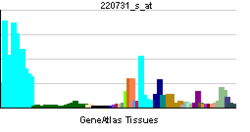- NECAP2
-
NECAP endocytosis associated 2 Identifiers Symbols NECAP2; FLJ10420; RP4-798A10.1 External IDs OMIM: 611624 MGI: 1913397 HomoloGene: 9168 GeneCards: NECAP2 Gene Gene Ontology Molecular function • protein binding Cellular component • intracellular
• plasma membrane
• coated pit
• clathrin vesicle coat
• cytoplasmic vesicleBiological process • endocytosis
• protein transportSources: Amigo / QuickGO RNA expression pattern 
More reference expression data Orthologs Species Human Mouse Entrez 55707 66147 Ensembl ENSG00000157191 ENSMUSG00000028923 UniProt Q9NVZ3 Q3TBZ6 RefSeq (mRNA) NM_001145277.1 NM_025383.3 RefSeq (protein) NP_001138749.1 NP_079659.1 Location (UCSC) Chr 1:
16.77 – 16.79 MbChr 4:
140.62 – 140.63 MbPubMed search [1] [2] Adaptin ear-binding coat-associated protein 2 is a protein that in humans is encoded by the NECAP2 gene.[1][2][3]
Interactions
NECAP2 has been shown to interact with AP1G1.[4]
References
- ^ Ritter B, Philie J, Girard M, Tung EC, Blondeau F, McPherson PS (Oct 2003). "Identification of a family of endocytic proteins that define a new α-adaptin ear-binding motif". EMBO Rep 4 (11): 1089–95. doi:10.1038/sj.embor.embor7400004. PMC 1326374. PMID 14555962. http://www.pubmedcentral.nih.gov/articlerender.fcgi?tool=pmcentrez&artid=1326374.
- ^ Ritter B, Blondeau F, Denisov AY, Gehring K, McPherson PS (Oct 2004). "Molecular mechanisms in clathrin-mediated membrane budding revealed through subcellular proteomics". Biochem Soc Trans 32 (Pt 5): 769–73. doi:10.1042/BST0320769. PMID 15494011.
- ^ "Entrez Gene: NECAP2 NECAP endocytosis associated 2". http://www.ncbi.nlm.nih.gov/sites/entrez?Db=gene&Cmd=ShowDetailView&TermToSearch=55707.
- ^ Mattera, Rafael; Ritter Brigitte, Sidhu Sachdev S, McPherson Peter S, Bonifacino Juan S (Feb. 2004). "Definition of the consensus motif recognized by gamma-adaptin ear domains". J. Biol. Chem. (United States) 279 (9): 8018–28. doi:10.1074/jbc.M311873200. ISSN 0021-9258. PMID 14665628.
Further reading
- Maruyama K, Sugano S (1994). "Oligo-capping: a simple method to replace the cap structure of eukaryotic mRNAs with oligoribonucleotides". Gene 138 (1–2): 171–4. doi:10.1016/0378-1119(94)90802-8. PMID 8125298.
- Suzuki Y, Yoshitomo-Nakagawa K, Maruyama K, et al. (1997). "Construction and characterization of a full length-enriched and a 5'-end-enriched cDNA library". Gene 200 (1–2): 149–56. doi:10.1016/S0378-1119(97)00411-3. PMID 9373149.
- Hartley JL, Temple GF, Brasch MA (2001). "DNA Cloning Using In Vitro Site-Specific Recombination". Genome Res. 10 (11): 1788–95. doi:10.1101/gr.143000. PMC 310948. PMID 11076863. http://www.pubmedcentral.nih.gov/articlerender.fcgi?tool=pmcentrez&artid=310948.
- Hattori A, Okumura K, Nagase T, et al. (2001). "Characterization of long cDNA clones from human adult spleen". DNA Res. 7 (6): 357–66. doi:10.1093/dnares/7.6.357. PMID 11214971.
- Simpson JC, Wellenreuther R, Poustka A, et al. (2001). "Systematic subcellular localization of novel proteins identified by large-scale cDNA sequencing". EMBO Rep. 1 (3): 287–92. doi:10.1093/embo-reports/kvd058. PMC 1083732. PMID 11256614. http://www.pubmedcentral.nih.gov/articlerender.fcgi?tool=pmcentrez&artid=1083732.
- Strausberg RL, Feingold EA, Grouse LH, et al. (2003). "Generation and initial analysis of more than 15,000 full-length human and mouse cDNA sequences". Proc. Natl. Acad. Sci. U.S.A. 99 (26): 16899–903. doi:10.1073/pnas.242603899. PMC 139241. PMID 12477932. http://www.pubmedcentral.nih.gov/articlerender.fcgi?tool=pmcentrez&artid=139241.
- Mattera R, Ritter B, Sidhu SS, et al. (2004). "Definition of the consensus motif recognized by gamma-adaptin ear domains". J. Biol. Chem. 279 (9): 8018–28. doi:10.1074/jbc.M311873200. PMID 14665628.
- Ota T, Suzuki Y, Nishikawa T, et al. (2004). "Complete sequencing and characterization of 21,243 full-length human cDNAs". Nat. Genet. 36 (1): 40–5. doi:10.1038/ng1285. PMID 14702039.
- Gerhard DS, Wagner L, Feingold EA, et al. (2004). "The Status, Quality, and Expansion of the NIH Full-Length cDNA Project: The Mammalian Gene Collection (MGC)". Genome Res. 14 (10B): 2121–7. doi:10.1101/gr.2596504. PMC 528928. PMID 15489334. http://www.pubmedcentral.nih.gov/articlerender.fcgi?tool=pmcentrez&artid=528928.
- Wiemann S, Arlt D, Huber W, et al. (2004). "From ORFeome to Biology: A Functional Genomics Pipeline". Genome Res. 14 (10B): 2136–44. doi:10.1101/gr.2576704. PMC 528930. PMID 15489336. http://www.pubmedcentral.nih.gov/articlerender.fcgi?tool=pmcentrez&artid=528930.
- Rual JF, Venkatesan K, Hao T, et al. (2005). "Towards a proteome-scale map of the human protein-protein interaction network". Nature 437 (7062): 1173–8. doi:10.1038/nature04209. PMID 16189514.
- Mehrle A, Rosenfelder H, Schupp I, et al. (2006). "The LIFEdb database in 2006". Nucleic Acids Res. 34 (Database issue): D415–8. doi:10.1093/nar/gkj139. PMC 1347501. PMID 16381901. http://www.pubmedcentral.nih.gov/articlerender.fcgi?tool=pmcentrez&artid=1347501.
- Gregory SG, Barlow KF, McLay KE, et al. (2006). "The DNA sequence and biological annotation of human chromosome 1". Nature 441 (7091): 315–21. doi:10.1038/nature04727. PMID 16710414.
Categories:- Human proteins
- Chromosome 1 gene stubs
Wikimedia Foundation. 2010.
